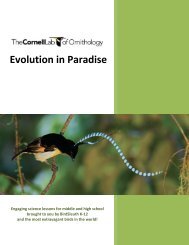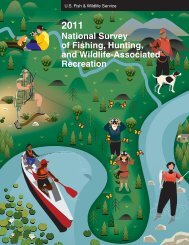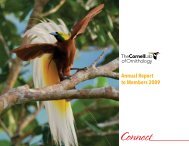BirdScope 11 Autumn 25(4)-For Annetta(2).pdf - All About Birds
BirdScope 11 Autumn 25(4)-For Annetta(2).pdf - All About Birds
BirdScope 11 Autumn 25(4)-For Annetta(2).pdf - All About Birds
You also want an ePaper? Increase the reach of your titles
YUMPU automatically turns print PDFs into web optimized ePapers that Google loves.
cePresenting the<strong>All</strong>-Time #1 Feeder BirdAt feeders all over the continent,one bird towers above allothers, at least in terms of occurrence.The Dark-eyed Juncovisits more than 80 percent ofall FeederWatchers in any givenyear. In any of its forms (the“slate-colored” and “Oregon”are the most widespread), thisplucky little snowbird is the perennialfeeder champion.What’s in the FeederWatch Kit?Project FeederWatch is a winter-long survey, andanyone can do it: children, families, teachers andstudents, retirees, coworkers on lunch breaks, naturecenters, and more. Participants count birdsat their feeders from November to early April ontwo consecutive days as often as once a week, thensend us their data. Join up and we'll send you a kitwith everything you need:• Handbook and instructions with tips forattracting birds to your yard.• FeederWatch calendar for planning countdays, illustrated with participants’ photos.• "Common Feeder <strong>Birds</strong>" poster withmore than 30 illustrations by field-guideartist Larry McQueen, including manyof those on this page.• Access to the FeederWatchforums, where participants share,discuss, and exchange help.A small annual fee, aboutthe price of half a bag ofsunflower seed, providesessential support for staff time, websitemaintenance, data analysis, and materials. Red-bellied Woodpecker White-breasted Nuthatch Eurasian Collared-DoveHow Many <strong>Birds</strong> Could You See?The more you look at your feeders, the more speciesyou'll see. Though northern winters are quiet,several dozen species are still the norm at manyfeeders. Farther south, winter can mean peakbirding—Arizona reports 85 species on its Feeder-Watch list.* No matter where you are, we needyour data to help fill in trends in occurrence anddistribution. In particular, the states of Nevada andHawaii need more participants.Number of speciesseen by at least 5%of participants70*Figures reflect the total number of species reported by at least5 percent of FeederWatchers in each state or province. Red-breasted Nuthatch<strong>All</strong> illustrations by Larry McQueen except:Eurasian Collared-Dove by Evaristo Hernandez-Fernandez; Sharp-shinned and Cooper’s hawks by Evan Barbouryears, a few birds have draandedtheir ranges. Redeckersand Carolina Wrensnorthward and now reguntersin New England, posofchanging climate or thelarity of birdfeeding.illaleref aveataiesons. Steller’s Jay Blue JayMonitoring DiseaseFeederWatchers have been indispensableat discovering and tracking bird diseases.In 1994 they discovered House Fincheye disease, which cut the eastern NorthAmerican population of House Finches inhalf as it spread across the continent. FeederWatchershelped track West Nile virusas it spread, too, and in 2002 their datahelped estimate the disease's heavy toll oncrows and jays. Since then, FeederWatchershave been equally crucial in recordingpopulation recoveries. Carolina Wren House Finch Eastern Towhee American RobinThe Dove No One SawComingOne of the most common birdsat feeders today—the EurasianCollared-Dove—wasn’t even inyour field guide when FeederWatchstarted. In the early 90s it was a curiositymostly restricted to south Florida.Since then it has rocketed acrossthe continent, appearingeverywhere except theNortheast. Last year, aFeederWatcher evenrecorded one in Alaska.You’ll Likely See More Than You ExpectA host of common birds come to feeders (see map,above, for the number of species that visit feeders inyour area). Each year FeederWatchers find the unexpectedtoo, from escaped parrots to national rarities.PFWchecklist No.1,000,000received American Goldfinch(transitional) Northern FlickerBusting the Top Five Myths<strong>About</strong> FeederWatch1. Ho-hum days are important data. “Predictable”counts are at the heart of FeederWatchdata—it’s exciting to report a rare bird, butcounting common birds—or even no birds—isevery bit as important.2. Robins aren’t just birds of spring. We thinkof robins as a sign of spring, but many gatherinto large, nomadic flocks in winter, even farin the north. You could see them at any time.3. Feeding birds won’t delay their migration.The main trigger for a bird’s migratory urge isday length. When it’s time to go, your feederswon’t keep birds from leaving—but they mightgive them the energy to go.4. <strong>Birds</strong> don’t get addicted to feeders. <strong>Birds</strong>may visit your feeder every day, but they actuallyget most of their food from natural sources.5. You are allowed to take your eyes off yourfeeder. Lots of people travel for the holidays.If you’ll be gone for part of the winter, you canstill collect valuable data during the time thatyou’re home.Evening Grosbeak Declines<strong>Birds</strong> move over vast areas, making population changesimpossible to detect from isolated counts. Widespread,long-term records like those of Project FeederWatchare essential for distinguishing normal population fluctuationsfrom true declines. FeederWatchers’ data havehelped researchers document this spectacular bird’sdecline—a 50 percent drop in the number of locationshosting this species over 20 years—giving us a handle onthe problem. Evening Grosbeak Common Redpoll2000 2005 2010RED: Common Redpolls, like many seed-eating finches, are irruptive species—every couple of years they range widely in response to changes in food supplies.FeederWatchers help map these irruptions across the continent.2012YELLOW: In the 1990s, Evening Grosbeaks showed an irruptive pattern similarto Common Redpolls, but by the 2000s overall counts were much lower, withless year-to-year fluctuation.






